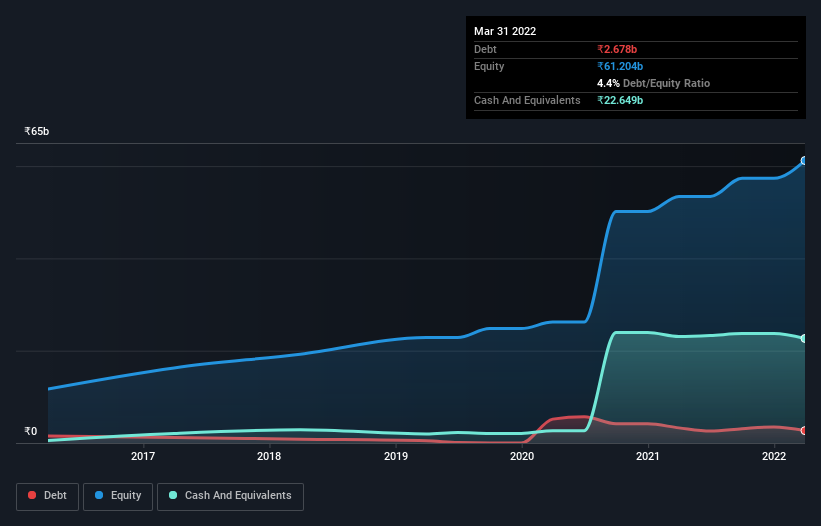Does PI Industries (NSE:PIIND) Have A Healthy Balance Sheet?

David Iben put it well when he said, 'Volatility is not a risk we care about. What we care about is avoiding the permanent loss of capital.' It's only natural to consider a company's balance sheet when you examine how risky it is, since debt is often involved when a business collapses. As with many other companies PI Industries Limited (NSE:PIIND) makes use of debt. But the more important question is: how much risk is that debt creating?
When Is Debt Dangerous?
Generally speaking, debt only becomes a real problem when a company can't easily pay it off, either by raising capital or with its own cash flow. Ultimately, if the company can't fulfill its legal obligations to repay debt, shareholders could walk away with nothing. However, a more common (but still painful) scenario is that it has to raise new equity capital at a low price, thus permanently diluting shareholders. Of course, plenty of companies use debt to fund growth, without any negative consequences. When we think about a company's use of debt, we first look at cash and debt together.
Check out our latest analysis for PI Industries
How Much Debt Does PI Industries Carry?
As you can see below, PI Industries had ₹2.68b of debt at March 2022, down from ₹3.28b a year prior. But it also has ₹22.6b in cash to offset that, meaning it has ₹20.0b net cash.

How Strong Is PI Industries' Balance Sheet?
According to the last reported balance sheet, PI Industries had liabilities of ₹13.5b due within 12 months, and liabilities of ₹3.23b due beyond 12 months. On the other hand, it had cash of ₹22.6b and ₹10.0b worth of receivables due within a year. So it actually has ₹16.0b more liquid assets than total liabilities.
This short term liquidity is a sign that PI Industries could probably pay off its debt with ease, as its balance sheet is far from stretched. Succinctly put, PI Industries boasts net cash, so it's fair to say it does not have a heavy debt load!
Also good is that PI Industries grew its EBIT at 12% over the last year, further increasing its ability to manage debt. When analysing debt levels, the balance sheet is the obvious place to start. But ultimately the future profitability of the business will decide if PI Industries can strengthen its balance sheet over time. So if you're focused on the future you can check out this free report showing analyst profit forecasts.
But our final consideration is also important, because a company cannot pay debt with paper profits; it needs cold hard cash. While PI Industries has net cash on its balance sheet, it's still worth taking a look at its ability to convert earnings before interest and tax (EBIT) to free cash flow, to help us understand how quickly it is building (or eroding) that cash balance. Looking at the most recent three years, PI Industries recorded free cash flow of 21% of its EBIT, which is weaker than we'd expect. That's not great, when it comes to paying down debt.
Summing up
While we empathize with investors who find debt concerning, you should keep in mind that PI Industries has net cash of ₹20.0b, as well as more liquid assets than liabilities. And it also grew its EBIT by 12% over the last year. So we are not troubled with PI Industries's debt use. Over time, share prices tend to follow earnings per share, so if you're interested in PI Industries, you may well want to click here to check an interactive graph of its earnings per share history.
At the end of the day, it's often better to focus on companies that are free from net debt. You can access our special list of such companies (all with a track record of profit growth). It's free.
New: Manage All Your Stock Portfolios in One Place
We've created the ultimate portfolio companion for stock investors, and it's free.
• Connect an unlimited number of Portfolios and see your total in one currency
• Be alerted to new Warning Signs or Risks via email or mobile
• Track the Fair Value of your stocks
Have feedback on this article? Concerned about the content? Get in touch with us directly. Alternatively, email editorial-team (at) simplywallst.com.
This article by Simply Wall St is general in nature. We provide commentary based on historical data and analyst forecasts only using an unbiased methodology and our articles are not intended to be financial advice. It does not constitute a recommendation to buy or sell any stock, and does not take account of your objectives, or your financial situation. We aim to bring you long-term focused analysis driven by fundamental data. Note that our analysis may not factor in the latest price-sensitive company announcements or qualitative material. Simply Wall St has no position in any stocks mentioned.
About NSEI:PIIND
PI Industries
An agrisciences company, engages in the manufacture and distribution of agrochemicals in India, rest of Asia, North America, Europe, and internationally.
Excellent balance sheet with proven track record and pays a dividend.


